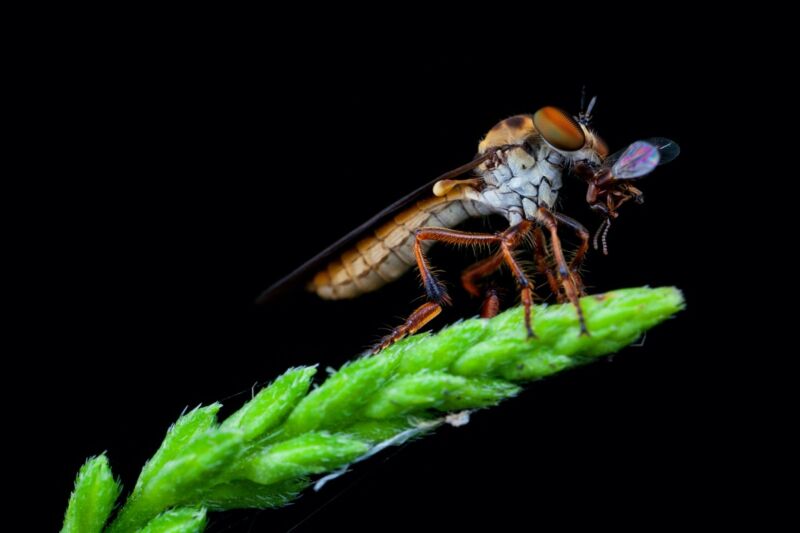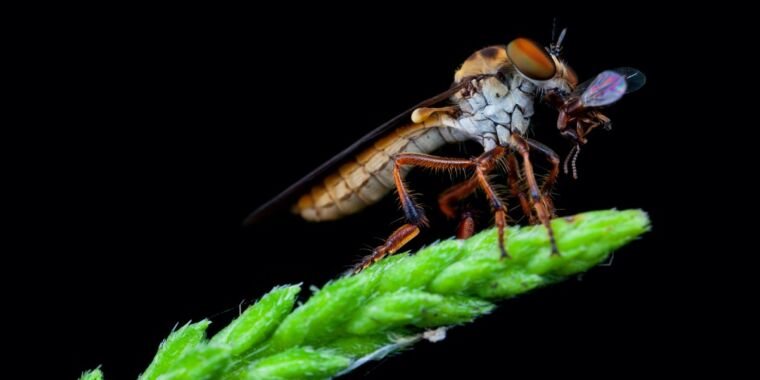
Samuel Fabian
Robber flies are aerodynamic acrobats, able to spot their prey, dodge around obstacles, and capture smaller insects at high speeds in midflights. Scientists have taken a closer look at how robber flies manage this amazing feat despite having brains on par with a single grain of sand. According to a new paper published in the Journal of Experimental Biology, the flies combine two distinct feedback-based navigation strategies: one that involves intercepting the prey when the view is clear, and another that allows the flies to swerve around any obstacles in their flight path.
One of the challenges in robotics is how to design robots that can navigate cluttered environments—something humans and other animals manage to do instinctively every day. Per the authors, many robotic systems rely upon a kind of path-planning: using sound (sonar) or lasers to send out signals and then detecting the reflections. That data can then be used to build a distance map of the surroundings.
But compared to using simple visual cues (i.e., “reactive methods”), path-planning is a costly approach in terms of energy use. Humans and other animals don’t require elaborate maps or specific knowledge about a target’s location, speed, and other details. We simply react to any relevant stimuli in our environment in real time. Devising navigational behavioral algorithms based on biological systems is thus of great interest to roboticists.
Past studies have focused on the ability of various species, including fruit flies and pigeons as well as humans, to negotiate cluttered environments. “However, in these instances, obstacle avoidance was the only goal,” the authors wrote. “Navigating around an obstacle is more challenging when a particular location acts as a target, because the aversion to obstacles must be balanced by the navigational goal.”
That’s why bioengineer Samuel Fabian of Imperial College, London and three collaborators from the University of Minnesota decided to conduct their own experiments using the predatory robber fly (Holocephala fusca) as a test subject. The robber fly was chosen because of its highly predictable interception path to catch prey. Also, its small size and relative fast behavior (most flights last less than a second) “require rapid reactions with minimum computational effort,” the authors wrote.
Fabian et al. liken the robber fly’s hunting behavior to that of falcons, hawks, and modern guided missiles. Robber flies typically hunt by perching somewhere that gives them a clear view of the sky. Once a robber fly spots potential prey and begins pursuit, the fly must navigate to both intercept the prey and avoid any obstacles along the way, such as errant branches.
The robber flies were presented with a moving target in the form of a small silver-colored reflective bead being pulled along a transparent fishing line with pulleys and a stepper motor. “The flies really didn’t know it’s not real prey, even when very close,” said Fabian. “If something is small enough, they generally seem to assume it’s food.”
The frame also held an obstacle: an acetate bar painted with black acrylic paint, either a thin (2.5 cm) or thick (5 cm) version, placed just below the path of the target. “The exact placement of the bar and the initial trajectory of the fly determined whether the object became an obstacle in the flight path and whether it obscured the target,” the authors wrote.
The researchers recorded all the flights under field conditions to get the most naturalistic behavior. Next, they digitally reconstructed 26 flights of robber flies pursuing the moving bead in the presence of an obstacle. Maneuvering the overhead equipment tended to startle the flies, so those 26 flights represent flies who remained on their perch as the apparatus was set up around them instead of flying away.
The results: when there was no obstacle, the robber flies maintained the same line of sight to the bead throughout their approach in order to intercept and capture their prey. When a thin or thick black bar partially obscured their view for brief periods (less than 0.1 second), the flies engaged in evasive maneuvers to get around the obstacle before getting back on course for an interception. Sometimes a fly would swerve in response to a black bar even when the bar didn’t obscure their line of sight. And when the researchers obscured the flies’ line of sight for longer than 0.1 second, the flies would abandon the interception entirely.
Fabian et al. concluded that the robber flies were employing a simple obstacle-avoidance strategy in combination with their standard interception strategy, which they have termed combined guidance. “The faster the obstacle is getting larger in their field of view, the more they turn away from it,” said Fabian. Flies revert to the interception trajectory once said obstacle begins to recede from view. “They are paying attention to their surroundings even when focused on the target.”
This “demonstrates that obstacle avoidance can be the product of simple feedback laws that do not require absolute knowledge of distance, size, or velocity,” the authors wrote, in keeping with prior work showing that simple feedback laws can also explain the flies’ interception strategy. Granted, this is based on a limited number of field trials, and the team hopes to conduct more trials in the future.
DOI: Journal of Experimental Biology, 2022. 10.1242/jeb.243568 (About DOIs).








